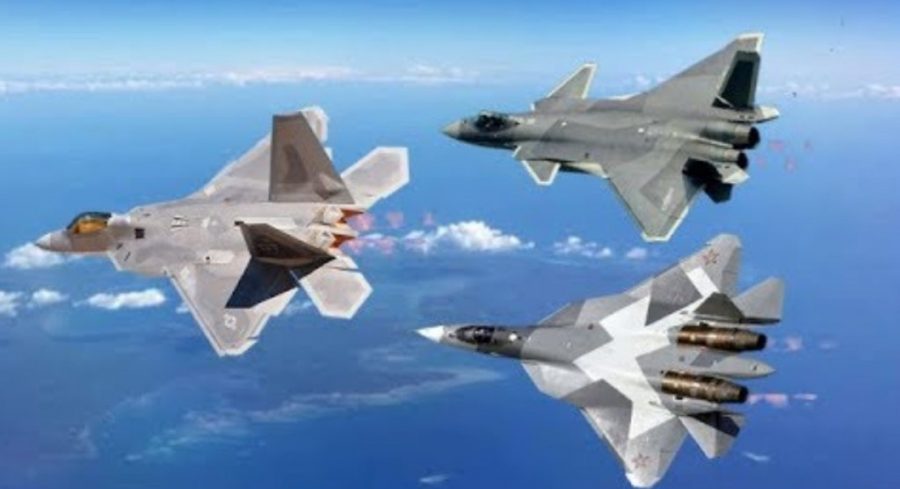Military Technology Update: Fifth-Generation Fighter Jets
April 1, 2019
World powers are constantly advancing their military technologies for purposes of self-defense and global power and influence. Since the success of the utilization of planes during World War II, the air has been the most important domain to have superiority in. Because of the rapidly advancing technologies, the world is now seeing a new generation of fighter jets emerge, ones with superb stealth technologies, supersonic speed and agility, and the newest and best software programs inside. This generation, the fifth generation, will quickly phase out the older fourth and four-and-a-half generation, and change the game for air superiority. Below are the four fifth-generation fighter jets of major world powers listed with their abilities.
 F-22
F-22
The F-22 Raptor is the United States Air Forces premier fighter jet. Developed by Lockheed Martin, the jet entered service with the United States Air Force in 2005. The jet is built as a replacement for the F-15 Eagle, as an air superiority fighter, with air to air combat at its core. The stealth gives it the advantage of not being seen, but should it need to be in a fight, it sports an impressive arsenal. Its main weapon is the M61A2 Vulcan, a 20 mm, 6 barrel Gatling gun that can fire at rates of 6,000 rounds per minute. It also has an internal weapons bay, which contains 10 air to air missiles and 2 laser-guided bombs. The jet has two Pratt & Whitney afterburner turbofan engines with thrust vectoring. They are designed for a super cruise, or the ability to fly at over supersonic without afterburners, and a top speed of Mach 2, while the thrust vectoring gives the jet incredible agility. The stealth capabilities allow the plane to have a radar signature similar to that of a hummingbird, and creates a new type of warfare. While optimized for dogfighting, the 150 mile radar range, and beyond visual range AIM-120 missiles allow the plane to strike a target from nearly 100 miles away without being detected. The only downside, which will limit the USAF to only 187, is the nearly $700 million lifetime cost.

F-35
While the F22 may be the sleek fast air superiority fighter, the United States has another plane in the works. The Lockheed Martin F-35 Lighting II is a workhorse with a planned 2,000 purchases from the US DoD and claimed to be the most advanced multi-role fighter. While it has many critics, the plane is often underestimated. It has three variants, A, B and C. The A variant is for conventional Air Force use, while the B variant serves the Marines with a STOVL, or short takeoff off vertical landing function, and the C variant is built for the Navy, with an arresting hook and catapult system for use on aircraft carriers. The fighter can carry out CAS and air superiority missions, with powerful weaponry. The main gun is a 25 mm 4 barreled Gatling gun with a firing rate of 3,300 rounds per minute. It can also house AAM and AGM in an internal weapons bay. And while all that sounds impressive, the F-35 is a terrible dogfighter. Its secret is in the technology, which is highly classified, but is said to be capable of never before seen things.
 J-20
J-20
The Chengdu J-20 is China’s first fifth-generation fighter, developed by the Chengdu Aerospace Corporation for the People’s Liberation Army Air Force(PLAAF). It was first revealed during the 2016 China International Aerospace Exhibition and formally entered service in March of 2017. The creation of this fighter jet is a part of China’s Great Rejuvenation plan. In fact, it did make a sensational first-time appearance, as controversies regarding its functionality rose amongst western military-strategists. One flaw, spotted by a significant amount of experts, is that the engine of the plane has severely affected its stealth abilities, as well as its mobility. An internal source from the PLAAF has also proved this suspect to be true. “There are still a series of technical problems that need to be tackled [on the J-20], including the reliability of its WS-15 engines, control system, stealth coat, and hull materials and the infrared sensor.” said the anonymous source. Another fatal flaw is the lack of a cannon, which is standard amongst fighter jets, and a near necessity in the air to air combat.
 Su-57
Su-57
As the second-ranked military power on this planet, the Russian Air Force has also deployed its own fifth-generation fighter jet to prepare for the future. The Sukhoi Su-57 was born as a product of the PAK FA plan: the ”prospective aeronautical complex of front-line air forces.” Its first flight reportedly took place on January 29th, 2010. The original program of developing a future generation fighter jets first took place in the former Soviet Union, and was expected to be complete by the 1990s. However, in opposition to the predicament, the fall of the eastern superpower led to a postponement of this program. It is all the way until 2002, that the program was restarted. Although ten prototypes have been tested until then, Russia has admitted that it is not planning to put the Su-57 into mass production in the recent future.
How the fifth generation fighter jets changed the games
The fifth-generation fighter jets are the products of the plane revolution during the twentieth century, which took decades to reach its ultimate result. However, without entering into mass production, the fifth-generation fighter jets cannot have any practical use in the short run except for functioning as a strategic deterrence. It would be very difficult to predict their actual effects in a battle because they have been never used in real combats. We can predict a change from the dogfights that ruled the 20th century, as stealth and beyond-visible-range missiles make combat more of a distant and hidden thing. However, the creation of these fighter jets themselves is a significant accomplishment and contributes to modern aerospace technology.






















